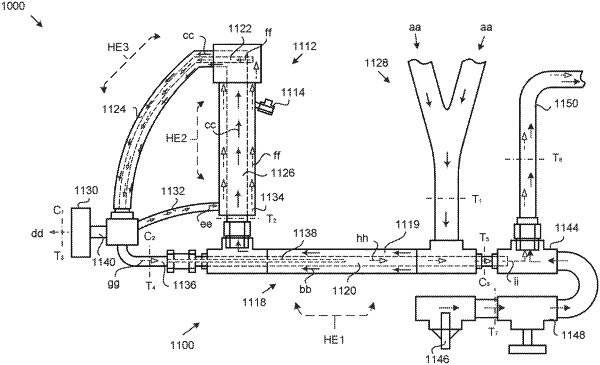| CPC F02M 26/36 (2016.02) [F01N 5/02 (2013.01); F02D 19/0671 (2013.01); F02M 27/02 (2013.01); F02M 31/08 (2013.01); F02M 31/14 (2013.01); F02M 31/16 (2013.01)] | 20 Claims |

|
5. A fuel treatment system for cracking hydrocarbons contained within a fuel for a combustion engine having at least one target combustion chamber; said fuel being selected from the group consisting of petrol, diesel, and fuel oil; said fuel treatment system comprising:
a ducting arrangement which includes:
a primary ducting component for ducting exhaust gas from an exhaust gas generation means and venting it to atmosphere, said primary ducting component including an exhaust gas inlet zone configured to receive the exhaust gas from the exhaust gas generation means, and an exhaust gas outlet vent;
a secondary ducting component in fluid communication with the primary ducting component, and with the target combustion chamber of the combustion engine, said secondary ducting component comprising:
an exhaust gas offtake connected to the primary ducting component, for diverting a portion of the exhaust gas from the primary ducting component to serve as a carrier gas for the fuel;
a fuel enrichment component connected to the exhaust gas offtake, for enriching the diverted carrier gas with fuel, thereby to provide a fuel-enriched carrier gas;
a processing chamber connected to the fuel enrichment component and having an inlet zone for receiving the fuel-enriched carrier gas from the fuel enrichment component, and an outlet zone connectable to the target combustion chamber; said processing chamber being configured to alter at least one characteristic of the fuel-enriched carrier gas selected from the group consisting of its chemical and physical characteristics;
turbulence-inducing formations provided in the secondary ducting component, for inducing turbulence in the fuel-enriched carrier gas; and
at least one elongate rod fixed in the processing chamber, wherein at least one spiral formation spirals around the rod, with spacings between successive coils of the spiral formation increasing progressively in the direction of flow of a fuel-enriched gas operatively flowing in the processing chamber;
wherein said exhaust gas inlet zone of the primary ducting component and said outlet zone of the processing chamber are configured in a heat exchange relationship with each other and in a substantially counter-current gas flow direction with respect to each other, such that heat from exhaust gas operatively flowing in a first direction in said exhaust gas inlet zone is operatively transferred to the fuel-enriched carrier gas flowing in the substantially counter-current direction in the outlet zone of the processing chamber, thereby to provide that heat from hottest volumes of the exhaust gas operatively flowing in a furthest upstream portion of the ducting arrangement is transferred to fuel-enriched carrier gas operatively flowing in a furthest downstream portion of the processing chamber; and
wherein at least one of the turbulence-inducing formations is selected from the group consisting of: vortex-inducing formations, vortex-creating formations, Schauberger formations, swirl-inducing formations, flow obstruction formations, flow deflection formations, flow redirection formations, laminar flow disrupting formations, matrices, jagged outcroppings projecting from interior surfaces of the processing chamber, rods, elongate flat dividers defining straight channels, grids, rings, turbulators, labyrinthine formations, knurled formations, topological formations, surface treatments, and surface deposition formations.
|